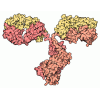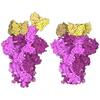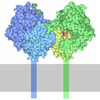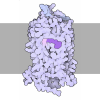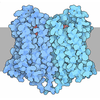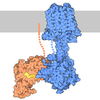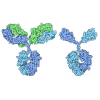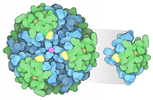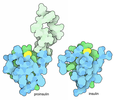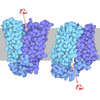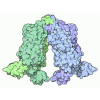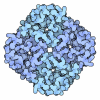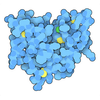+ Open data
Open data
- Basic information
Basic information
| Entry | Database: PDB / ID: 8ikh | ||||||
|---|---|---|---|---|---|---|---|
| Title | Cryo-EM structure of human receptor with G proteins | ||||||
 Components Components |
| ||||||
 Keywords Keywords | MEMBRANE PROTEIN / complex / allosteric modulator | ||||||
| Function / homology |  Function and homology information Function and homology informationcannabinoid signaling pathway / retrograde trans-synaptic signaling by endocannabinoid / cannabinoid receptor activity / regulation of presynaptic cytosolic calcium ion concentration / Class A/1 (Rhodopsin-like receptors) / axonal fasciculation / regulation of metabolic process / G protein-coupled receptor signaling pathway, coupled to cyclic nucleotide second messenger / adenylate cyclase inhibitor activity / positive regulation of protein localization to cell cortex ...cannabinoid signaling pathway / retrograde trans-synaptic signaling by endocannabinoid / cannabinoid receptor activity / regulation of presynaptic cytosolic calcium ion concentration / Class A/1 (Rhodopsin-like receptors) / axonal fasciculation / regulation of metabolic process / G protein-coupled receptor signaling pathway, coupled to cyclic nucleotide second messenger / adenylate cyclase inhibitor activity / positive regulation of protein localization to cell cortex / Adenylate cyclase inhibitory pathway / T cell migration / D2 dopamine receptor binding / response to prostaglandin E / adenylate cyclase regulator activity / G protein-coupled serotonin receptor binding / adenylate cyclase-inhibiting serotonin receptor signaling pathway / cellular response to forskolin / regulation of mitotic spindle organization / Regulation of insulin secretion / positive regulation of cholesterol biosynthetic process / negative regulation of insulin secretion / G protein-coupled receptor binding / G protein-coupled receptor activity / response to peptide hormone / adenylate cyclase-inhibiting G protein-coupled receptor signaling pathway / GABA-ergic synapse / adenylate cyclase-modulating G protein-coupled receptor signaling pathway / G-protein beta/gamma-subunit complex binding / centriolar satellite / Olfactory Signaling Pathway / Activation of the phototransduction cascade / G beta:gamma signalling through PLC beta / Presynaptic function of Kainate receptors / Thromboxane signalling through TP receptor / G protein-coupled acetylcholine receptor signaling pathway / adenylate cyclase-activating G protein-coupled receptor signaling pathway / Activation of G protein gated Potassium channels / Inhibition of voltage gated Ca2+ channels via Gbeta/gamma subunits / G-protein activation / Prostacyclin signalling through prostacyclin receptor / G beta:gamma signalling through CDC42 / Glucagon signaling in metabolic regulation / G beta:gamma signalling through BTK / Synthesis, secretion, and inactivation of Glucagon-like Peptide-1 (GLP-1) / ADP signalling through P2Y purinoceptor 12 / photoreceptor disc membrane / Sensory perception of sweet, bitter, and umami (glutamate) taste / Glucagon-type ligand receptors / Adrenaline,noradrenaline inhibits insulin secretion / Vasopressin regulates renal water homeostasis via Aquaporins / GDP binding / Glucagon-like Peptide-1 (GLP1) regulates insulin secretion / G alpha (z) signalling events / cellular response to catecholamine stimulus / ADP signalling through P2Y purinoceptor 1 / ADORA2B mediated anti-inflammatory cytokines production / G beta:gamma signalling through PI3Kgamma / adenylate cyclase-activating dopamine receptor signaling pathway / Cooperation of PDCL (PhLP1) and TRiC/CCT in G-protein beta folding / GPER1 signaling / Inactivation, recovery and regulation of the phototransduction cascade / cellular response to prostaglandin E stimulus / G-protein beta-subunit binding / heterotrimeric G-protein complex / glucose homeostasis / G alpha (12/13) signalling events / sensory perception of taste / extracellular vesicle / actin cytoskeleton / signaling receptor complex adaptor activity / Thrombin signalling through proteinase activated receptors (PARs) / retina development in camera-type eye / G protein activity / presynaptic membrane / growth cone / GTPase binding / Ca2+ pathway / fibroblast proliferation / midbody / High laminar flow shear stress activates signaling by PIEZO1 and PECAM1:CDH5:KDR in endothelial cells / cell cortex / G alpha (i) signalling events / G alpha (s) signalling events / phospholipase C-activating G protein-coupled receptor signaling pathway / G alpha (q) signalling events / Hydrolases; Acting on acid anhydrides; Acting on GTP to facilitate cellular and subcellular movement / Ras protein signal transduction / mitochondrial outer membrane / Extra-nuclear estrogen signaling / cell population proliferation / ciliary basal body / G protein-coupled receptor signaling pathway / membrane raft / lysosomal membrane / cell division / GTPase activity / synapse / centrosome / GTP binding Similarity search - Function | ||||||
| Biological species |  Homo sapiens (human) Homo sapiens (human) | ||||||
| Method | ELECTRON MICROSCOPY / single particle reconstruction / cryo EM / Resolution: 3.3 Å | ||||||
 Authors Authors | Shen, S.Y. / Shao, Z.H. | ||||||
| Funding support |  China, 1items China, 1items
| ||||||
 Citation Citation |  Journal: Proc Natl Acad Sci U S A / Year: 2024 Journal: Proc Natl Acad Sci U S A / Year: 2024Title: Structure-based identification of a G protein-biased allosteric modulator of cannabinoid receptor CB1. Authors: Siyuan Shen / Chao Wu / Guifeng Lin / Xin Yang / Yangli Zhou / Chang Zhao / Zhuang Miao / Xiaowen Tian / Kexin Wang / Zhiqian Yang / Zhiyu Liu / Nihong Guo / Yueshan Li / Anjie Xia / Pei ...Authors: Siyuan Shen / Chao Wu / Guifeng Lin / Xin Yang / Yangli Zhou / Chang Zhao / Zhuang Miao / Xiaowen Tian / Kexin Wang / Zhiqian Yang / Zhiyu Liu / Nihong Guo / Yueshan Li / Anjie Xia / Pei Zhou / Jingming Liu / Wei Yan / Bowen Ke / Shengyong Yang / Zhenhua Shao /  Abstract: is known for its therapeutic benefit in various diseases including pain relief by targeting cannabinoid receptors. The primary component of cannabis, Δ9-tetrahydrocannabinol (THC), and other ... is known for its therapeutic benefit in various diseases including pain relief by targeting cannabinoid receptors. The primary component of cannabis, Δ9-tetrahydrocannabinol (THC), and other agonists engage the orthosteric site of CB1, activating both Gi and β-arrestin signaling pathways. The activation of diverse pathways could result in on-target side effects and cannabis addiction, which may hinder therapeutic potential. A significant challenge in pharmacology is the design of a ligand that can modulate specific signaling of CB1. By leveraging insights from the structure-function selectivity relationship (SFSR), we have identified Gi signaling-biased agonist-allosteric modulators (ago-BAMs). Further, two cryoelectron microscopy (cryo-EM) structures reveal the binding mode of ago-BAM at the extrahelical allosteric site of CB1. Combining mutagenesis and pharmacological studies, we elucidated the detailed mechanism of ago-BAM-mediated biased signaling. Notably, ago-BAM demonstrated analgesic efficacy with fewer side effects, minimal drug toxicity and no cannabis addiction in mouse pain models. In summary, our finding not only suggests that ago-BAMs of CB1 provide a potential nonopioid strategy for pain management but also sheds light on BAM identification for GPCRs. | ||||||
| History |
|
- Structure visualization
Structure visualization
| Structure viewer | Molecule:  Molmil Molmil Jmol/JSmol Jmol/JSmol |
|---|
- Downloads & links
Downloads & links
- Download
Download
| PDBx/mmCIF format |  8ikh.cif.gz 8ikh.cif.gz | 206.6 KB | Display |  PDBx/mmCIF format PDBx/mmCIF format |
|---|---|---|---|---|
| PDB format |  pdb8ikh.ent.gz pdb8ikh.ent.gz | 157.8 KB | Display |  PDB format PDB format |
| PDBx/mmJSON format |  8ikh.json.gz 8ikh.json.gz | Tree view |  PDBx/mmJSON format PDBx/mmJSON format | |
| Others |  Other downloads Other downloads |
-Validation report
| Summary document |  8ikh_validation.pdf.gz 8ikh_validation.pdf.gz | 1.3 MB | Display |  wwPDB validaton report wwPDB validaton report |
|---|---|---|---|---|
| Full document |  8ikh_full_validation.pdf.gz 8ikh_full_validation.pdf.gz | 1.3 MB | Display | |
| Data in XML |  8ikh_validation.xml.gz 8ikh_validation.xml.gz | 40.4 KB | Display | |
| Data in CIF |  8ikh_validation.cif.gz 8ikh_validation.cif.gz | 59.6 KB | Display | |
| Arichive directory |  https://data.pdbj.org/pub/pdb/validation_reports/ik/8ikh https://data.pdbj.org/pub/pdb/validation_reports/ik/8ikh ftp://data.pdbj.org/pub/pdb/validation_reports/ik/8ikh ftp://data.pdbj.org/pub/pdb/validation_reports/ik/8ikh | HTTPS FTP |
-Related structure data
| Related structure data |  35512MC  8ikgC M: map data used to model this data C: citing same article ( |
|---|---|
| Similar structure data | Similarity search - Function & homology  F&H Search F&H Search |
- Links
Links
- Assembly
Assembly
| Deposited unit | 
|
|---|---|
| 1 |
|
- Components
Components
-Guanine nucleotide-binding protein ... , 3 types, 3 molecules ABC
| #1: Protein | Mass: 40415.031 Da / Num. of mol.: 1 Source method: isolated from a genetically manipulated source Source: (gene. exp.)  Homo sapiens (human) / Gene: GNAI1 / Production host: Homo sapiens (human) / Gene: GNAI1 / Production host:  |
|---|---|
| #2: Protein | Mass: 39141.793 Da / Num. of mol.: 1 Source method: isolated from a genetically manipulated source Source: (gene. exp.)  Homo sapiens (human) / Gene: GNB1 / Production host: Homo sapiens (human) / Gene: GNB1 / Production host:  |
| #3: Protein | Mass: 7861.143 Da / Num. of mol.: 1 Source method: isolated from a genetically manipulated source Source: (gene. exp.)  Homo sapiens (human) / Gene: GNG2 Homo sapiens (human) / Gene: GNG2Production host: Insect cell expression vector pTIE1 (others) References: UniProt: P59768 |
-Protein / Antibody / Non-polymers , 3 types, 3 molecules RS
| #4: Protein | Mass: 35168.027 Da / Num. of mol.: 1 Source method: isolated from a genetically manipulated source Source: (gene. exp.)  Homo sapiens (human) / Gene: CNR1, CNR / Production host: Homo sapiens (human) / Gene: CNR1, CNR / Production host:  |
|---|---|
| #5: Antibody | Mass: 28636.793 Da / Num. of mol.: 1 Source method: isolated from a genetically manipulated source Source: (gene. exp.)   |
| #6: Chemical | ChemComp-Q2L / Mass: 372.417 Da / Num. of mol.: 1 / Source method: obtained synthetically / Formula: C23H20N2O3 / Feature type: SUBJECT OF INVESTIGATION |
-Details
| Has ligand of interest | Y |
|---|
-Experimental details
-Experiment
| Experiment | Method: ELECTRON MICROSCOPY |
|---|---|
| EM experiment | Aggregation state: PARTICLE / 3D reconstruction method: single particle reconstruction |
- Sample preparation
Sample preparation
| Component |
| ||||||||||||||||||||||||||||||
|---|---|---|---|---|---|---|---|---|---|---|---|---|---|---|---|---|---|---|---|---|---|---|---|---|---|---|---|---|---|---|---|
| Source (natural) |
| ||||||||||||||||||||||||||||||
| Source (recombinant) |
| ||||||||||||||||||||||||||||||
| Buffer solution | pH: 7.5 | ||||||||||||||||||||||||||||||
| Specimen | Embedding applied: NO / Shadowing applied: NO / Staining applied: NO / Vitrification applied: YES | ||||||||||||||||||||||||||||||
| Vitrification | Cryogen name: ETHANE |
- Electron microscopy imaging
Electron microscopy imaging
| Experimental equipment |  Model: Titan Krios / Image courtesy: FEI Company |
|---|---|
| Microscopy | Model: FEI TITAN KRIOS |
| Electron gun | Electron source:  FIELD EMISSION GUN / Accelerating voltage: 300 kV / Illumination mode: FLOOD BEAM FIELD EMISSION GUN / Accelerating voltage: 300 kV / Illumination mode: FLOOD BEAM |
| Electron lens | Mode: BRIGHT FIELD / Nominal defocus max: 1800 nm / Nominal defocus min: 1000 nm / Cs: 0.01 mm |
| Image recording | Electron dose: 65 e/Å2 / Film or detector model: GATAN K3 (6k x 4k) |
- Processing
Processing
| CTF correction | Type: PHASE FLIPPING AND AMPLITUDE CORRECTION |
|---|---|
| 3D reconstruction | Resolution: 3.3 Å / Resolution method: FSC 0.143 CUT-OFF / Num. of particles: 251705 / Symmetry type: POINT |
 Movie
Movie Controller
Controller




 PDBj
PDBj